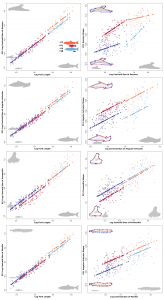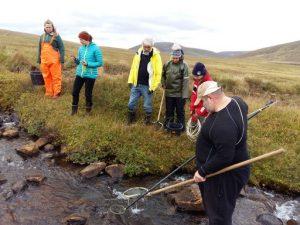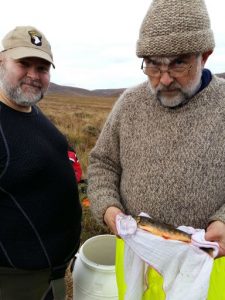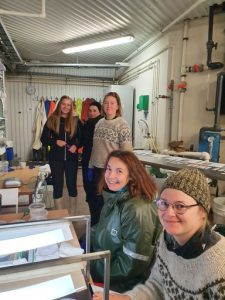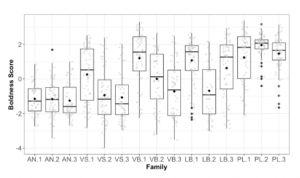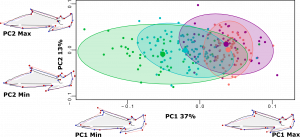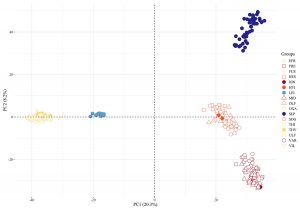The prey availability and diet of juvenile Atlantic salmon (Salmo salar L.) in low-productivity rivers in northern Europe
The prey availability and diet of juvenile Atlantic salmon (Salmo salar L.) in low-productivity rivers in northern Europe
accepted for publication in the Journal of Fish Biology. http://doi.org/10.1111/jfb.15757
Authors:
Sum Yi Lai1,2, Arnar Pálsson2, Guðni Guðbergsson1, Ingi Rúnar Jónsson1, Jón S. Ólafsson1, Hlynur Bárðarson1
1. Marine and Freshwater Research Institute, Hafnarfjördur, Iceland
2. University of Iceland, Reykjavík, Iceland
Corresponding author: Name: Sum Yi Lai Address: Marine and Freshwater Research Institute, Fornubúdir 5, 220 Hafnarfjördur, Iceland,
Email: sammi.lai@hafogvatn.is
Abstract:
The availability of resources varies across a species distributional range, and a low productivity area can make a species more vulnerable. We investigated the invertebrate composition and prey choice of juvenile Atlantic salmon (Salmo salar L.) in low productivity rivers at Northeast Iceland, which is one of the species´ most northerly distributions. By sampling benthic and drift invertebrate populations, we found that prey availability was similar within and between rivers. Gut content samples showed that the main prey choice for juvenile S. salar was the Chironomidae. The type of food items consumed varied across different weight groups of S. salar, with smaller juveniles having more diverse diet. S. salar did not have a selection preference for chironomids, which indicate that they were eating the highly available prey in their environment, rather than hunting high biomass items such as terrestrial invertebrates and large Dipterans. Estimates of dietary niche showed that S. salar in these low-productivity rivers relied on consuming what was most readily available, the chironomids, and that they must share resources with other salmonid species. This may be due to the low diversity of freshwater invertebrates (fewer prey options), whereas S. salar in nutrient-rich rivers could rely more on terrestrial invertebrates as an additional subsidy in their diet. In conclusion, with limited prey choices, juvenile S. salar in nutrient-poor rivers, especially in a biogeographically isolated region with low species diversity, may increase in vulnerability and decrease in adaptability to environmental change. Management methods that increase benthic prey abundance and diversity are recommended for conserving S. salar population in a nutrient-poor river
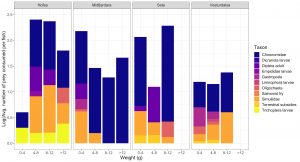
Log10 average number of prey items found in stomachs of juvenile Atlantic salmon (Salmo salar) was differed significantly across rivers (p<0.001) and by weight ranges (p<0.001).
The number of prey items consumed increased with weight (p<0.05). Log10 abundance also varies between taxonomic groups for all rivers (p<0.001) with abundances of Chironomidae higher in comparison.
Symposium of Molecular Evolution: In Honor of Marty Kreitman’s Scientific Career
It was at the Drosophila meeting in San Diego 10-14th of April 2002. I had arrived with my uncle Einar Arnason and his late wife Betty, after driving down from Passadena. In the ginormous reception ball room we snacked and drank, until Einar was bundled by a springly fellow with wired hair and manners. Marty Kreitman had arrived at the scene.
Drosophila Research Conference (drosophila-conf.org)
I had greatly admired his population genetic work, though it was the work Marty did with Misha Ludwig that particularly impressed me. The first did population genetics on the best characterized regulatory element at the time, the stripe 2 enhancer of the eve (even-skipped) gene of D. melanogaster, and then moved to functional studies, comparing the element between species. See for instance a very impressive paper on chimeras of D. melanogaster and D. pseudoobscura s2e enhancers.
Evidence for stabilizing selection in a eukaryotic enhancer element.
To make a long story short, serendipity helped me make Marty´s acquaintance and a year later I started a postdoc with him and Misha at the University of Chicago. There we had three fun years doing population genetics on enhancers and analyzing gene expression in embryos.
Functional evolution of a cis-regulatory module. 2005. Ludwig MZ, Palsson A, Alekseeva E, Bergman CM, Nathan J, Kreitman M. PLoS Biology. 3(4):e93. (doi:10.1371/journal.pbio.0030093 PDF)
Canalization of segmentation and its evolution in Drosophila. 2007. Lott SE, Kreitman M, Palsson A, Alekseeva E, Ludwig MZ. Proc Natl Acad Sci U S A. 104(26):10926-31. (doi: 10.1073/pnas.0701359104 PDF)
Naturally Occurring Deletions of Hunchback Binding Sites in the Even-Skipped Stripe 3+7 Enhancer. 2014. Palsson A, Wesolowska N, Reynisdóttir S, Ludwig MZ, Kreitman M. PLoS ONE 9(5): e91924. doi:10.1371/journal.pone.0091924.
In the summer of 2022 former trainees and friends of Marty arranged a nice farewell symposium for him in Chicago. Thankfully I got to participate via zoom, and see some of the great people again.
(Icelandic) Diversity of bones - resubmission in progress
The manuscript got quite favorable replies.
https://www.biorxiv.org/content/10.1101/2023.02.17.528955v2
We are continuing uploading the figures to Figshare+ and code to Github.
And adjusting the figures with new colour-blind friendlier palette.
See for instance.
Variation in personality shaped by evolutionary history, genotype and developmental plasticity in response to feeding modalities in the Arctic charr
Variation in personality shaped by evolutionary history, genotype and developmental plasticity in response to feeding modalities in the Arctic charr
Variation in personality shaped by evolutionary history, genotype, and developmental plasticity
"Dear Dr DellingerI am pleased to inform you that your manuscript RSPB-2023-2302 entitled "Variation in personality shaped by evolutionary history, genotype, and developmental plasticity in response to feeding modalities in the Arctic charr" has been accepted for publication in Proceedings B."
Dellinger, Marion; Steele, Sarah; Sprockel, Evert; Philip, Joris; Pálsson, Arnar; Benhaïm, David.
Very welcome outcome. Congrats to Sarah Steele and Marion Dellinger who led the study.
Boldness in behavior varied substantially by morphs, and also by families in some of the morphs, though noticably least in Anadromous (left) and planktivorous charr from Þingvallavatn (right).
Diversity in the internal functional feeding elements of sympatric morphs of Arctic charr (Salvelinus alpinus)
Submission of Guðbjörgs manuscript to PLoS One, second version of M.S. available on bioRxiv.
Diversity in the internal functional feeding elements of sympatric morphs of Arctic charr (Salvelinus alpinus)
The diversity of functional feeding anatomy is particularly impressive in fishes and correlates with various interspecific ecological specializations. Intraspecific polymorphism can manifest in divergent feeding morphology and ecology, often along a benthic pelagic axis. Arctic charr (Salvelinus alpinus) is a freshwater salmonid known for morphological variation and sympatric polymorphism and in Lake Þingvallavatn, Iceland, four morphs of charr coexist that differ in preferred prey, behaviour, habitat use, and external feeding morphology. We studied variation in six upper and lower jaw bones in adults of these four morphs using geometric morphometrics and univariate statistics. We tested for allometric differences in bone size and shape among morphs, morph effects on bone size and shape, and divergence along the benthic-pelagic axis. We also examined the degree of integration between bone pairs. We found differences in bone size between pelagic and benthic morphs for two bones (dentary and premaxilla). There was clear bone shape divergence along a benthic pelagic axis in four bones (dentary, articular angular, premaxilla and maxilla), as well as allometric shape differences between morphs in the dentary. Notably for the dentary, morph explained more shape variation than bone size. Comparatively, benthic morphs possess a compact and taller dentary, with shorter dentary palate, consistent with visible (but less prominent) differences in external morphology. As these morphs emerged in the last 10,000 years, these results indicate rapid functional evolution of specific feeding structures in arctic charr. This sets the stage for studies of the genetics and development of rapid and parallel craniofacial evolution.
Plot of two principal components separates three clusters of landlocked brown trout, the Scottish reference group, and the anadromous populations. The percentage of the variance explained by these components is shown in parentheses. See ms for three letter code.
Genetic structure and relatedness of brown trout (Salmo trutta) populations in the drainage basin of the Ölfusá river, South-Western Iceland
Accepted in PeerJ. Good job by Marcos G. Lagunas.
Background. Lake Þingvallavatn in Iceland, a part of the river Ölfusá drainage basin, was presumably populated by brown trout soon after it formed at the end of the last Ice Age. The genetic relatedness of the brown trout in Þingvallavatn to other populations in the Ölfusá drainage basin is unknown. After the building of a dam at the outlet of the lake in 1959 brown trout catches declined, though numbers have now increased. The aim of this study was to assess effects of geographic isolation and potential downstream gene flow on the genetic structure and diversity in brown trout sampled in several locations in the western side of the watershed of River Ölfusá. We hypothesized that brown trout in Lake Þingvallavatn constituted several local spawning populations connected by occasional gene flow before the damming of the lake. We also estimated the effective population size (NE) of some of these populations and tested for signs of a recent population bottleneck in Lake Þingvallavatn.
Methods. We sampled brown trout inhabiting four lakes and 12 rivers within and near the watershed of River Ölfusá by means of electro- and net- fishing. After stringent data filtering, 2,597 polymorphic loci obtained from ddRADseq data from 317 individuals were ascertained as putative neutral markers.
Results. Overall, the genetic relatedness of brown trout in the Ölfusá watershed reflected the connectivity and topography of the waterways. Ancestry proportion analyses and a phylogenetic tree revealed seven distinct clusters, some of which corresponded to small populations with reduced genetic diversity. There was no evidence of downstream gene flow from Lake Þingvallavatn, although gene flow was observed from much smaller mountain populations. Most locations showed low NE values (i.e., ~14.6 on average) while the putative anadromous trout from River Sog and the spawning population from River Öxará, that flows into Lake Þingvallavatn, showed notably higher NE values (i.e., 71.2 and 56.5, respectively). No signals of recent population bottlenecks were detected in the brown trout of Lake Þingvallavatn.
Discussion. This is the first time that the genetic structure and diversity of brown trout in the Ölfusá watershed have been assessed. Our results point towards the presence of a metapopulation in the watershed of Lake Þingvallavatn (and its tributaries), which has been influenced by restoration efforts and is now dominated by a genetic component originated in River Öxará. Many of the locations studied represent different populations. Those that are isolated in headwater streams and lakes are genetically distinct presenting low genetic diversity, yet they can be important in increasing the genetic variation in downstream populations. These populations should be considered for conservation and direct management.

